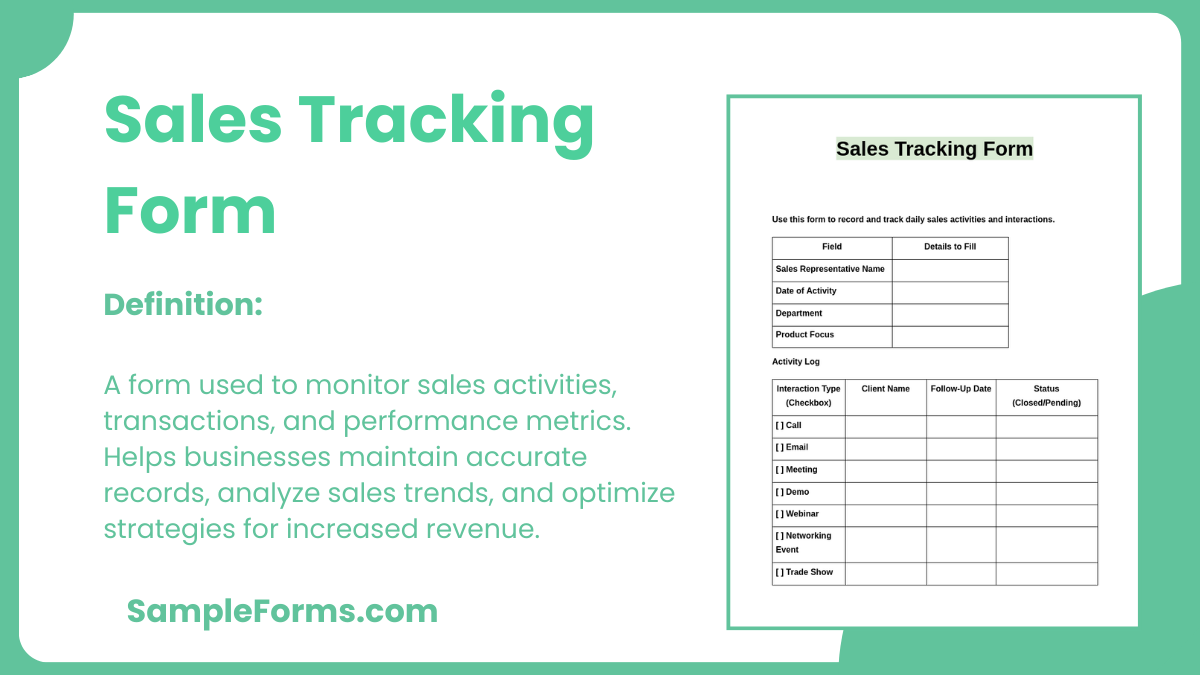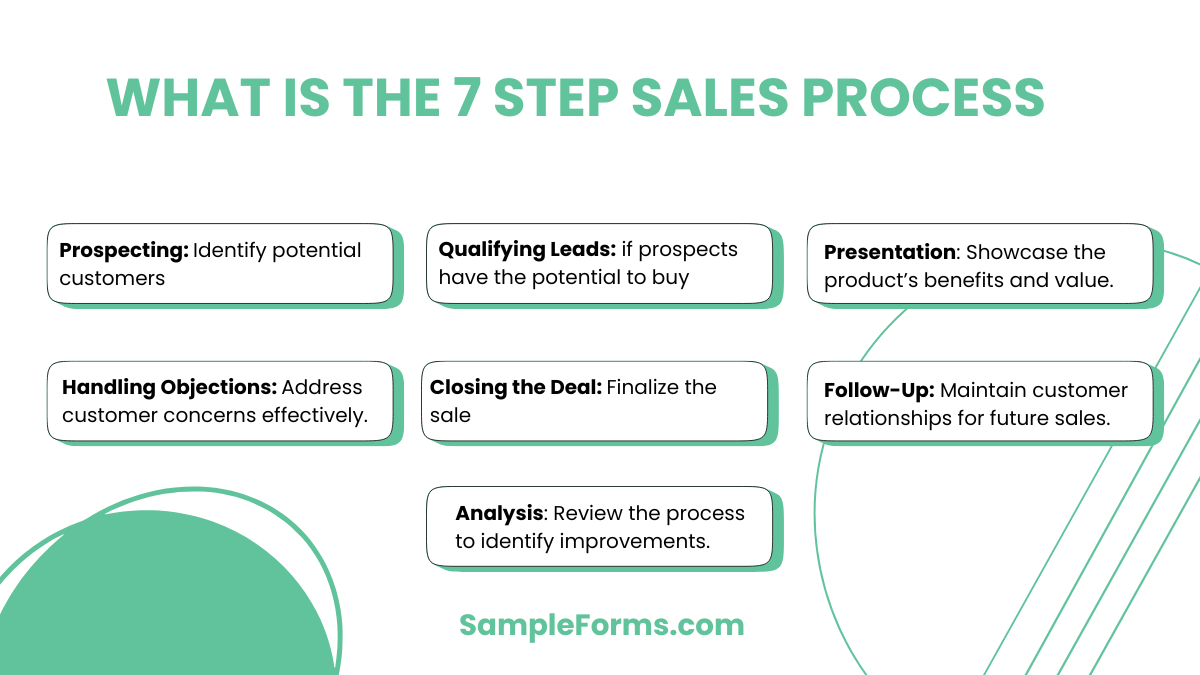A Sales Tracking Form is essential for businesses looking to streamline their sales processes and boost efficiency. Whether you’re managing a small team or a large salesforce, having a structured way to track sales activities, performance metrics, and client interactions can significantly improve your results. This guide provides examples, templates, and best practices to help you leverage sales tracking effectively. By using a well-designed Tracking Form and Sales Report Form, companies can quickly identify trends, optimize sales strategies, and improve revenue outcomes.
Download Sales Tracking Form Bundle
What is Sales Tracking Form?
A Sales Tracking Form is a tool used to record, monitor, and evaluate sales activities and performance metrics. It helps businesses stay on top of their sales processes, track customer interactions, and measure outcomes. By utilizing a structured approach, it ensures that sales data is organized and easily accessible for reporting and analysis, helping businesses make informed decisions and drive growth.
Sales Tracking Format
Heading: Sales Performance Tracking Form for [Quarter/Year]
1. Sales Representative Information
- Full Name, Employee ID, Department, and Region/Territory.
2. Client Details
- Capture client information, including Company Name, Contact Person, Email, and Phone Number.
3. Sales Metrics
- Columns for tracking sales targets, achieved sales, revenue generated, discounts given, and any returns or refunds processed.
Product Details
- Include product name, SKU, quantity sold, unit price, and total value.
4. Sales Activities & Follow-ups
- Track meetings, follow-ups, status updates (e.g., open, closed, or lost deals), and next action items.
5. Performance Review & Feedback
- Space for sales managers to review performance, provide feedback, and set targets for the upcoming period.
6. Approval & Sign-off
- Include a section for signatures of the sales representative and their manager.
Sales Activity Tracking Form
A Sales Activity Tracking Form is a tool designed to document daily sales interactions, client meetings, and follow-ups. It helps sales teams monitor progress, set targets, and analyze performance trends. Proper use of this form ensures that every customer touchpoint is logged, enhancing accountability. For businesses focused on efficient employee management, integrating this form with an Employee Tracking Form can optimize productivity and client engagement.
Monthly Sales Tracking Form
The Monthly Sales Tracking Form is ideal for summarizing a business’s monthly sales activities, targets achieved, and revenue generated. It provides a bird’s-eye view of performance, helping managers assess trends and adjust strategies for the coming months. This form allows companies to monitor long-term goals effectively. For better time management, aligning it with a Time Tracking Form can improve overall efficiency in tracking sales timelines and deadlines.
Sales Commission Tracking Form
A Sales Commission Tracking Form helps businesses accurately calculate and track commissions for their sales representatives. It includes fields for recording individual sales, commission rates, and total payouts. Ensuring transparency in commission payouts fosters motivation and trust among employees. To make transactions official, businesses can pair this form with a Car Sale Contract Form when dealing with high-ticket sales.
Daily Sales Tracking Form
The Daily Sales Tracking Form is perfect for businesses that need to keep a close watch on their day-to-day sales activities. It captures sales data in real-time, allowing managers to identify performance gaps early and adjust strategies promptly. This form helps maintain consistent sales records, which can be cross-referenced with a Sales Evaluation Form to ensure accuracy in financial documentation and customer transactions.
Browse More Sales Tracking Forms
Sample Daily Sales Tracking Form
Ticket Sales Tracking Form
Outside Sales Tracking Forms
Sample Customer Sales Tracking Forms
Sales Call Tracking Forms
Sales Activity Tracking Forms
Sales Activity Tracker by Week
Sample Salon Sales Tracker Form
Standard Sales Tracking Form
Scout Sales Tracking Form
How to make a sales tracker?
Creating a sales tracker involves organizing sales data systematically to monitor performance and optimize sales strategies. It ensures streamlined processes and effective tracking of sales activities.
Adhering to specific rules ensures accurate tracking:
- Select a Template: Utilize a pre-designed Sales Agreement Form to input relevant sales details.
- Data Entry: Include fields for customer information, products, quantities, and sales figures.
- Automated Calculations: Use formulas to calculate totals and percentages for sales analysis.
- Visualization Tools: Implement graphs to visualize sales trends.
- Regular Updates: Ensure the tracker is updated daily to maintain accuracy.
What are sales tracking tools?
Sales tracking tools help businesses automate data collection, monitor sales activities, and generate insights for better decision-making. These tools optimize sales efficiency and streamline processes.
Key features include:
- CRM Integration: Link with systems like Salesforce to store customer data using a Sales Receipt Form.
- Reporting Features: Generate reports to analyze sales performance.
- Automation: Automate follow-ups and notifications.
- Real-Time Data: Track sales in real-time for quick adjustments.
- Customization: Tailor fields to fit specific business needs.
How do you keep track of customers in sales?
Tracking customers ensures personalized interactions and effective follow-ups, fostering long-term relationships. It enhances customer satisfaction and retention rates.
Best practices include:
- CRM Systems: Store customer information using a Sales Order Form for easy access.
- Segmentation: Group customers based on buying behavior.
- Follow-Up Schedules: Automate follow-ups for customer engagement.
- Feedback Collection: Gather customer opinions to improve services.
- Data Security: Protect customer data with encryption.
How do small businesses track sales?
Small businesses need efficient methods to track sales without incurring high costs. Simple yet effective techniques can enhance business operations.
Steps include:
- Manual Spreadsheets: Use Excel to track sales using a Behavior Tracking Form
- Invoicing Software: Automate sales documentation and payments.
- Mobile Apps: Utilize apps to record on-the-go sales.
- Cloud Storage: Store data securely for remote access.
- Daily Reports: Generate reports to monitor progress.
What is the 7 step sales process?
The 7-step sales process involves structured stages to convert prospects into loyal customers. It enhances efficiency and sales outcomes.
Key stages:
- Prospecting: Identify potential customers using a Purchase and Sale Agreement.
- Qualifying Leads: Determine if prospects have the potential to buy.
- Presentation: Showcase the product’s benefits and value.
- Handling Objections: Address customer concerns effectively.
- Closing the Deal: Finalize the sale with proper documentation.
- Follow-Up: Maintain customer relationships for future sales.
- Analysis: Review the process to identify improvements.
How do I track my sales?
Use digital tools or a Sales Lead Form to monitor sales activities. This helps record interactions, forecast revenue, and optimize strategies for better results.
What is a sales order form?
A Sale Contract Form details the purchase agreement between a buyer and seller, listing products, quantities, prices, and terms of sale.
How to track sales in retail?
Retailers use POS systems and a Sales Agreement to capture and analyze sales data for inventory management and customer insights.
How do sales reps stay organized?
Sales reps rely on CRM software, tracking tools, and structured Sales of Goods Agreement Contract Form to manage their daily activities effectively.
What is the easiest way to record sales?
Manual or automated entry using a Sales Receipt ensures accurate record-keeping and streamlines the sales process for quick reference.
How to create a daily sales report?
Generate reports using templates or software, incorporating data from a Sales Contract to monitor daily revenue, customer interactions, and product performance.
How to organize sales data?
Organize sales data using spreadsheets or CRM tools, supplemented by a Sales Proposal for structured and efficient data retrieval.
How do I create a sales talk track?
Develop structured talking points using a Salesperson Agreement Contract Form to ensure clarity and consistency during client presentations.
How do you keep track of items sold?
Use inventory management systems or a Sales Appraisal Form to monitor stock levels and manage sold items efficiently.
How to create sales talking points?
Craft persuasive talking points using examples from a Notice of Sale Form to address customer pain points and highlight product benefits.
How to document personal property sales?
When selling personal items, use a Vehicle Sales Agreement Contract Form to record details, ensuring transparency and compliance.
What is a car sale form used for?
A Car Sale Form documents the transfer of vehicle ownership, listing terms, conditions, and buyer-seller agreements for legal assurance.
Using a Sales Tracking Form can transform how businesses manage their sales operations. It streamlines the reporting process, making it easier to monitor performance and identify areas for improvement. Additionally, integrating it with a Sales Invoice Form ensures a seamless flow of data, from tracking activities to invoicing clients, thereby optimizing sales efficiency.
Related Posts Here
-
Waiting List Form
-
Restaurant Schedule Form
-
Mobile Home Bill of Sale
-
Landlord Consent Form
-
60-Day Notice to Vacate Form
-
Financial Statement Form
-
Product Evaluation Form
-
Construction Contract
-
School Receipt Form
-
Restaurant Training Form
-
Daily Cash Log
-
Volleyball Evaluation Form
-
Holding Deposit Agreement Form
-
License Agreement Short Form
-
Fund Transfer Form

